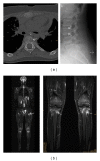Update: Cytokine Dysregulation in Chronic Nonbacterial Osteomyelitis (CNO)
- PMID: 22685464
- PMCID: PMC3364585
- DOI: 10.1155/2012/310206
Update: Cytokine Dysregulation in Chronic Nonbacterial Osteomyelitis (CNO)
Abstract
Chronic nonbacterial osteomyelitis (CNO) with its most severe form chronic recurrent multifocal osteomyelitis (CRMO) is a non-bacterial osteitis of yet unknown origin. Secondary to the absence of both high-titer autoantibodies and autoreactive T lymphocytes, and the association with other autoimmune diseases, it was recently reclassified as an autoinflammatory disorder of the musculoskeletal system. Since its etiology is largely unknown, the diagnosis is based on clinical criteria, and treatment is empiric and not always successful. In this paper, we summarize recent advances in the understanding of possible etiopathogenetic mechanisms in CNO.
Figures


References
-
- Giedion A, Holthusen W, Masel LF, Vischer D. Subacute and chronic “symmetrical” osteomyelitis. Annales de Radiologie. 1972;15(3):329–342. - PubMed
-
- Bjorksten B, Gustavson KH, Eriksson B, Lindholm A, Nordström S. Chronic recurrent multifocal osteomyelitis and pustulosis palmoplantaris. Journal of Pediatrics. 1978;93(2):227–231. - PubMed
-
- Hamel J, Paul D, Gahr M, Hedrich CM. Pilot study: possible association of IL10 promoter polymorphisms with CRMO. Rheumatology International. 2011;32(2):555–556. - PubMed
-
- Iyer RS, Thapa MM, Chew FS. Chronic recurrent multifocal osteomyelitis: review. American Journal of Roentgenology. 2011;196(6, supplement):S87–S91. - PubMed
LinkOut - more resources
Full Text Sources

